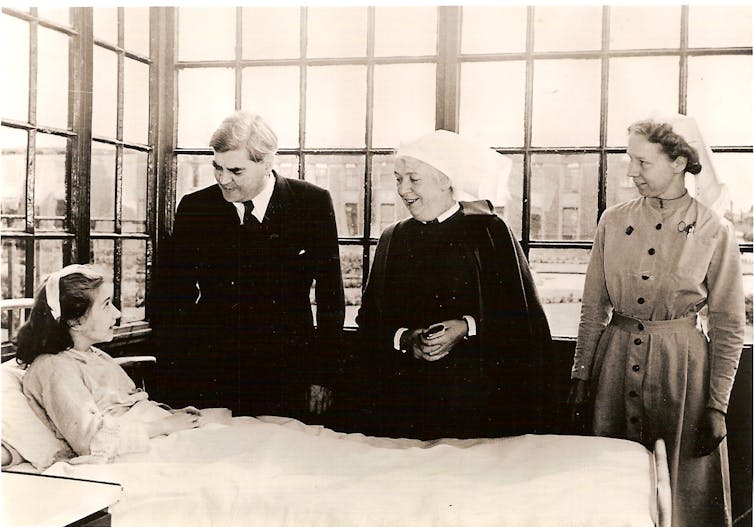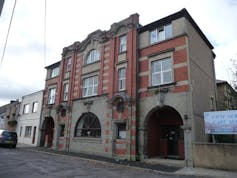NHS was not solely modelled on a Welsh workmen’s medical society
05 July 2018
<h1>NHS was not solely modelled on a Welsh workmen's medical society</h1>

Anenurin Bevan, Minister of Health, on the first day of NHS at Park Hospital Davyhulme near Manchester.
Wikimedia/University of Liverpool Faculty of Health & Life Sciences, CC BY-SA
Steve Thompson, Aberystwyth University
The 70th anniversary of the NHS holds a special significance for the people of Tredegar, south Wales. Ask any inhabitant and they will tell you that Aneurin Bevan, their most famous son, built the national health service in imitation of a workmen’s scheme that provided medical care in the town until 1948.
But this claim that Bevan modelled the NHS on the Tredegar Workmen’s Medical Aid Society is not 100% correct – the truth is a little more complex than that.
The Tredegar society was one of the most robust, comprehensive and democratic of all the various workers’ health schemes that existed before the NHS. Its roots lie in 19th-century industrialisation when, in common with other iron and coal businesses, the Tredegar Iron and Coal Company appointed a doctor to serve the needs of workers. Compulsory deductions were made from workers’ pay and the money was paid to the doctor – a doctor who could only be appointed or dismissed by the company.
This lack of control was a source of bitterness and workers complained that while they paid the piper, they rarely got to call the tune. So, in the late 1800s and early 1900s, many workers across south Wales took over and workmen’s committees and set about enhancing the basic features.
Under these more sophisticated schemes, doctors were employed on set salaries and any surplus funds were used to extend the services available to members. By the 1920s members of the Tredegar society – which now included “town members” from among Tredegar’s middle class as well as workers not employed by the steel company – had at their disposal the services of five doctors, one surgeon, two pharmacists, a physiotherapist, a dentist and a district nurse.
In return for an extra payment of four pennies a week, the Tredegar society also offered hospital care to members. Depending on the particular ailment or complaint, patients could be treated at the local cottage hospital, or at larger hospitals, with more consultant specialists, in nearby Newport or Cardiff, or further afield at Bristol, Bath, Hereford and London. The society even owned a car that could take the patient from their home to the railway station, where a first-class ticket awaited to transport them to the hospital.
The worker-controlled, democratic society was responsive to the particular needs of members, and a wide range of medical and health benefits were made available. Convalescent and maternity homes, sunray and ultraviolet treatment, glasses, false teeth, artificial limbs, dietary supplements, injections, patent foods, drugs and medicines, X-rays and even wigs were prescribed.
Given the society’s apparent socialism, it is perhaps ironic that several features lauded by progressives for their mutualist qualities were pioneered by the iron masters. These included providing treatment for “dependent” wives and children and instituting a system of payment under which better paid workers subsidised the healthcare of less well paid colleagues, allowing them to have a higher standard of care than they might have otherwise had.
Imitation or inspiration?
As Bevan set to the task of creating a national health service, the committee at Tredegar sought a continued role for the society within the NHS. They were told by Bevan: “You have shown us the way and by your very efficiency you have brought about your own cessation.” He was sentimental about people, but not institutions, and he saw no place for the society in his new service.
It is possible that Bevan was recognising a debt and paying tribute to an inspiration. Or he sought to soothe the injured feelings of constituents who were not going to get their way. Bevan’s statement, however, was not an assertion that the NHS had been modelled directly on Tredegar’s society. Neither was his often quoted line that he was going to “Tredegarise” Britain.

Tredegar Medical Aid Society’s central surgery, built in 1911.
Jeremy Bolwell, CC BY-SA
Before 1948, British healthcare was a ramshackle mixed economy of provision. Researchers have since placed the foundations of the NHS in a longer-term context. The importance of the medical arm of the Poor Law, which provided care for the poorest in communities, the creation of the health insurance system in 1911, the evolution of the voluntary hospital system (where subscribers could sponsor patients for admission), and the development of municipal medicine run by local authorities, all provided the context in which Bevan drew up his plans.
Read more:
What was healthcare like before the NHS?
Other schemes and initiatives that attracted comment at the time might have helped guide Bevan in his decision making, too. In the 1930s, the Pioneer Health Centre sought to cultivate good health as much as treat illness in the “Peckham experiment”. Similarly, the Scottish Highlands and Islands Medical Service, founded in 1913, attracted attention for its integrated health services that were provided through direct state support.
Certainly, in 1937, the progressive think tank, Political and Economic Planning, believed that workers’ medical schemes might form the basis for a national service. And in 1946, the influential magazine, Picture Post, published an article on the Tredegar scheme titled: “Where Bevan Got his National Health Plan.” But whether any one initiative or service can be truly said to be the source of something as large and complex as the NHS is perhaps doubtful and, in the end, even irrelevant.
Long-term developments in providing healthcare in Britain clearly had important implications for what was feasible in the 1940s. Existing facilities could hardly be scrapped and replaced by a completely new system.
Whatever the case, the Tredegar scheme consisted of a comprehensive system of healthcare and medical provision for the entire community, free at the point of use and democratically managed for the good of all. It was undoubtedly inspirational to Bevan, even if he rejected the local basis on which it operated, and constituted a considerable achievement of which Tredegar is rightly very proud.
More evidence-based articles about the NHS:
Steve Thompson, Senior Lecturer in History, Aberystwyth University
This article was originally published on The Conversation. Read the original article.



